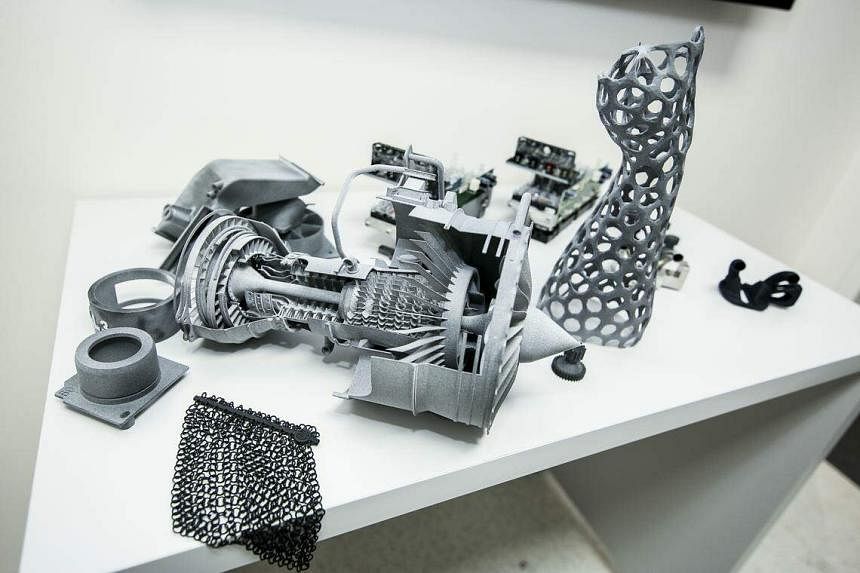SINGAPORE – The inkjet printer, which dates back to the 1970s, may be considered a dinosaur in a digital age where people swipe screens more than they flip pages of paper.
But some of the most advanced inkjet printer heads are being produced in Depot Road in Singapore, and their American maker HP is readying the robotic ink dispensers for a bigger purpose and a brighter future.
Specifically, scientists are using HP’s inkjet technology to “print” micro samples used in the discovery of new drugs and vaccines, as well as separate cancer cells from normal cells in cancer research labs.
“We can separate cancer cells from normal cells when we apply some electromagnetic fields to a micro stream of liquid,” HP chief executive Enrique Lores told The Straits Times in an exclusive interview.
“Not only is the technology more precise, it is also unique. I don’t think there is any similar technology today,” he said.
Inkjet printer heads can manipulate liquids to be studied in miniaturised chambers and tunnels measured in tens to hundreds of micrometres. These measurements are similar to that of a strand of hair, pollen, bacteria and viruses.
HP’s pivot to this multidisciplinary scientific field, known as microfluidics, is opening up an entirely new income stream for the company, which has seen falling consumer demand for computers and printers cut into profits.
Fluid manipulation – which includes filtering, heating and pumping – has so far not been automated in a way that inkjet technology can provide, said Mr Lores.
He was in Singapore last week at the company’s Asia-Pacific headquarters to meet customers and staff, his first visit here since 2020, when the Covid-19 pandemic halted overseas travel.
Citing an example of what inkjet technology is capable of, he said that the creation of samples in scientific labs – which is usually done with pipettes and can be time-consuming and prone to errors – could take more than one hour for just 20 samples.
The same number of samples can be “printed” in under four minutes, he said.
The technology’s capability was demonstrated during the height of the Covid-19 pandemic in 2020 when laboratories around the world were racing to test drugs and vaccines to stem the spread of the virus.
In 2020, HP donated inkjet printers, dubbed BioPrinters, to major research institutions in the United States and Europe.
This allowed researchers to quickly print pharmaceutical samples in volumes ranging from picolitres to microlitres to accelerate drug and vaccine research.

The initiative was part of a larger US$8 million (S$10.7 million) technology and grant donation by HP and HP Foundation, the company’s charity arm, to support blended learning and healthcare needs due to Covid-19.
With the BioPrinters, for instance, the Spanish National Research Council was able to investigate how the spike protein on the Covid-19 virus reacts in people who are most at risk of infection.
Researchers from the Centre for Nuclear Receptors and Cell Signalling at the University of Houston in the US also used HP’s BioPrinters to dispense reagents for Covid-19 drug development, while Italy’s Monoclonal Antibody Discovery Laboratory at Fondazione Toscana Life Sciences used the printers to test the potency of certain antibodies against Covid-19.
Mr Lores said that microfluidics will be key to what HP describes as its “growth businesses”.
HP’s growth businesses also include video-conferencing, gaming, industrial printing and 3D printing, which collectively contributed more than US$11 billion to the firm’s total revenue for the year ended Oct 31, 2022.
The new businesses registered “double-digit” revenue growth in 2022, he added.
For the year ended Oct 31, 2022, HP’s total net revenue declined 0.8 per cent to US$63 billion from the year before.
Its growth businesses made up one-sixth of total net revenue in 2022, but are poised to reinvent the company.
In particular, HP is printing metal and plastic parts for some of the largest vehicle-makers and medical companies in the world.
They include German motor vehicle maker Volkswagen, sailing equipment maker Ubi Maior Italia, Spanish railway system maker CAF, French dental prosthetic maker Biotech Dental and British orthotic device maker Crispin Orthotics.
In July 2021, HP launched a new company called Arize to create better-fitting prosthetics and orthotics, devices worn on the body to help correct structural issues or provide support.
Through 3D printing, healthcare professionals are able to customise these devices – whether they are sockets for prosthetic limbs, helmets for newborns or casts for broken bones – for individual patients.

These new opportunities have given the decades-old inkjet technology a new lease of life, amid declining consumer demand for computers and printers.
In November 2022, HP joined many other tech firms in laying off workers following a slump in sales.
It announced plans to cut 4,000 to 6,000 jobs, or about 10 per cent of its 61,000 global workforce, over the next three years.
Its current global workforce stands at 55,000 employees.
It is not known how many employees in Singapore were affected by the global cuts.
HP, which set up shop in Singapore in 1970, had as many as 9,000 employees in Singapore in 1998.
It currently employs more than 3,000 workers here, with some 60 per cent of local staff involved in research and development (R&D) activities.
Mr Lores is confident that Singapore will remain relevant as HP’s global manufacturing base for printer heads and one of its seven global R&D centres for printers.
“In Singapore, we build some of the most advanced inkjet printer heads, which are what we use in many of these (new) applications,” he added.
“We don’t look at Singapore as just a manufacturing centre,” he said. “We do much more R&D here.”


